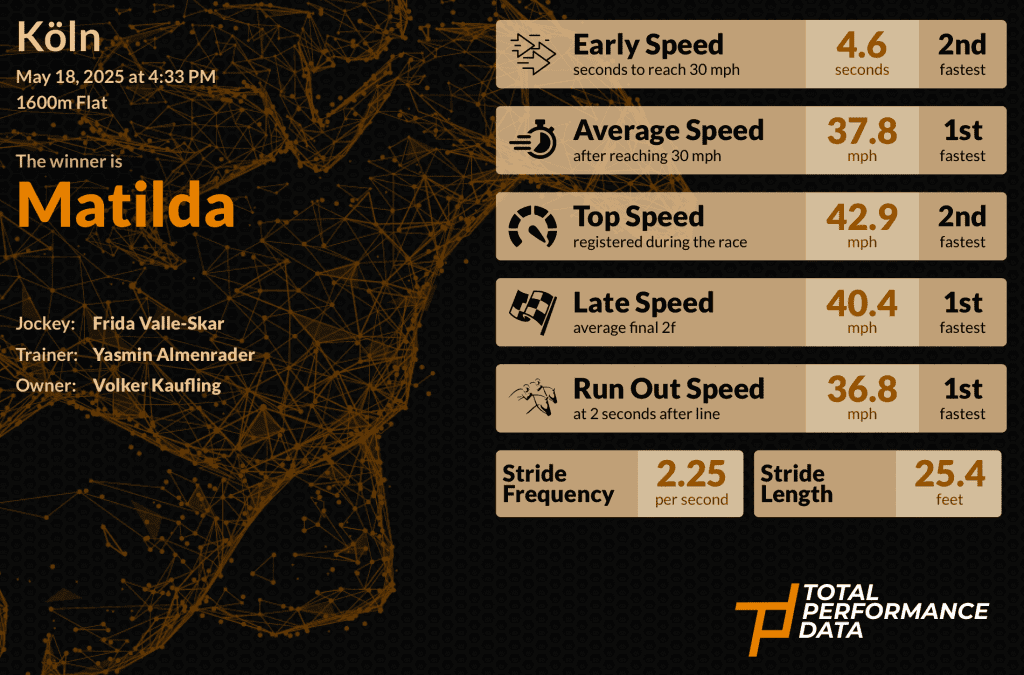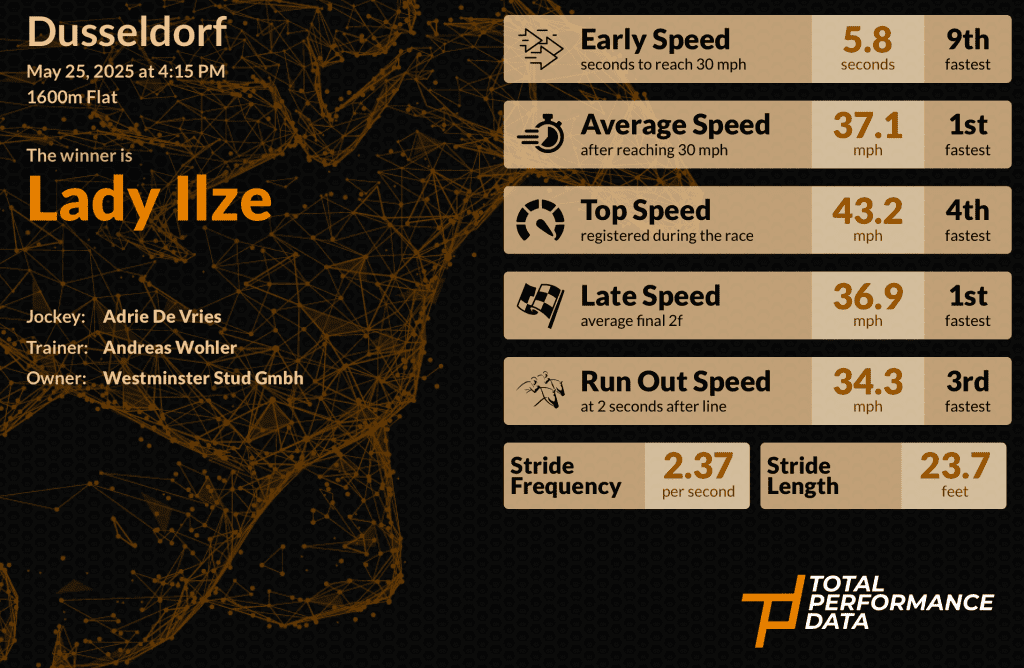There’s a German feel to this week’s review of the data from TPD as we look back at the first 2 Classics of the season that were run a week apart at Cologne and Dusseldorf. Both races were won by impressive Fillies and I will start by looking at the victory of Matilda last Sunday, who became the first filly to win the German 2,000 Guineas in over 50-years.


Sunday 18th May
Coolmore City of Troy German 2,000 Guineas (Group 2)
Matilda became the first filly to win this race in over 50-years as she delivered a 6-length demolition under Frida Valle-Skar for trainer Yasmin Almenrader. Settled behind the pace, she loomed alongside the leader at the 2-furlong pole, responding quickly to her rider’s encouragement to put distance between herself and the remainder of the field in the straight. A top speed of 42.9 mph, which coincided with a sub 11-second furlong in the home straight proved far too fast for most of her rivals and having recorded a run-out speed of 36.8 mph 2-seconds after crossing the line, it would be fair to assume that she should be capable of staying further in time. At an average length of 25.43 ft, she produced an identical stride length to the runner-up, but had a much higher top speed and peak stride frequency than he did and there is no reason to doubt this form in the future were they to meet again. Having won over this course and distance 4-weeks ago, this was a big step forward and whilst an International SP of 25/1 might suggest that this was a freak result, the data from TPD would contradict that approach to the form.
When a horse wins a race by 6-lengths it is always important to add some context to it and I will now attempt to do so here. I’ll start with the runner-up, Ciaran. This was a clever piece of race planning from Maurizio Guarnieri, who got his Colt ready for this with a run at Compiegne in a Class 2 event at the end of April. He has definitely improved as a 3-year-old and the application of cheek pieces has helped him to see out his races. However, he was the only Colt in a field of Fillies at Compiegne and the French handicapper has given him a rating of 44-kilos, the equivalent to 97 in the UK. He stayed on well to finish 2nd, albeit a long way behind Matilda, but having conceded 3 lbs to her, it does put a slightly different spin on the form.
The other major question from this form would be the performance of Vertical Blue, who trailed in last of the 9-runners. She beat Zarigana in the Prix Marcel Boussac at Paris Longchamp in October, but offered very little as she faded in the final 2-furlongs on Sunday. At an average of 25.92 ft, she had the longest stride in the field and it is possible to explain her poor showing on the tight turns and the fact that she may now be ready to step up in trip. However, she was over 1.2s slower than the winner in the final quarter of a mile and her run-out speed of 32.93 mph, wouldn’t necessarily support the theory that she was outpaced and in need of 2,000m. This was her first start since October and in a recent stable tour Francis-Henri Graffard did state that “She has taken a while to come out of the winter”, but this was still a disappointing run from a Filly with Group 1 form as a juvenile.
It’s important to recognise how good Matilda was on Sunday and even if Vertical Blue had run a better race, she may not have beaten her, but I thought that the notes above were important to add when assessing this form in the future. The winner of this race gets a free entry into the St James’ Palace stakes at Royal Ascot next month. That is probably a step too far for Matilda, but there is every reason to believe that she could be a capable filly in Group 1 company later in the year.


Sunday 25th May
Horn & Company – 105th German 1,000 Guineas (Group 2)
Lady Ilze had finished 4th in one of the trials for this race at Cologne 3-weeks ago, but that race didn’t really pan out for a filly who is patiently ridden and the stronger early pace here saw her to much better effect as she readily reversed the form with Santagada (finished 4th) to win by a length. This was a 6th win in the race for her trainer Andreas Wohler, who first won this with Tryphosa back in 1995. A top speed of 43.20 mph saw her ranked 4th, but she closed well down the middle of the track with the fastest 6th and 7th furlongs in the race. Lady Ilze is a relatively compact filly with an average recorded stride length of 23.65 ft, but she is perfectly suited to the tight turns at Dusseldorf and a peak average stride frequency of 2.48 per second was the key. That was the highest frequency in the field and allowed her to quicken in the straight to get herself to the front. Both the 2nd and 3rd recorded faster run-out speeds, but she had the race won with 100-yards to go after some clever race riding by Adrie de Vries. Is she capable of stepping up into Group 1 company on the back of this? Probably not. I’d certainly argue that Matilda achieved more 7-days earlier, but she is going the right way and should continue to be competitive at this level in Fillies’ races.
D’ores et Deja won the Listed Henkel-Stutenpreis over course and distance in April and brings a relatively solid look to this form. She stayed on well to close on the winner in the final 100-yards and had to work her way through runners in the closing stages at a time when Lady Ilze had a clear run down the outside. She lacked the tactical speed to get herself to the front, but she had the fastest run-out speed in the field at 35.19 mph and should probably be capable of staying 10-furlongs on this evidence. Both D’ores et Deja and the 3rd placed Place Fontenay finished their races well and at 24.38 ft, the latter recorded a much longer average stride length than the first 2 and may well improve on a more galloping track next time.
Flaming Stone was a disappointing favourite, eventually finishing 6th under Thore Hammer Hansen. She had some smart form in France, including a close 2nd placed finish behind Mandanaba at Paris Longchamp in April. It’s hard to find an excuse, as she had every chance when tracking the pace set by Pershing. Perhaps the track was the reason for her poor performance? At 24.90 ft, her average stride length was the longest in the field and the tight turns may have limited her ability to lengthen in the closing stages, but even allowing for that this run was some way behind her earlier form in France. Similar comments must surely apply to David Loughnane’s filly Anshoda. She was considered good enough to run at the Breeders’ Cup in November but trailed in last of the 9-runners here despite having the perfect position behind the leader after taking just 4.8s to get to 30 mph from the stalls. This was her first start of the year and having worked hard from a wide draw in the early stages she may well have done too much too soon. She won the Prestige Stakes at Goodwood last August and it’s too soon to be writing her off on the back of this effort, though she will need to improve significantly next time to reach that level of form. Ollie Sangster’s Ellaria Sand had no such excuse. This was her 3rd run of the season, but despite racing just in front of the winner towards the rear of the field, she failed to pick up and was never a threat. She won a Listed race at Newbury on Heavy ground in October, so the softer conditions can’t be used as a reason for this performance and she could only be watched next time on the back of this.